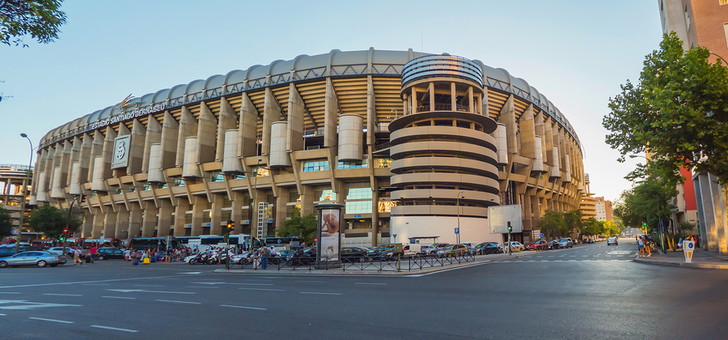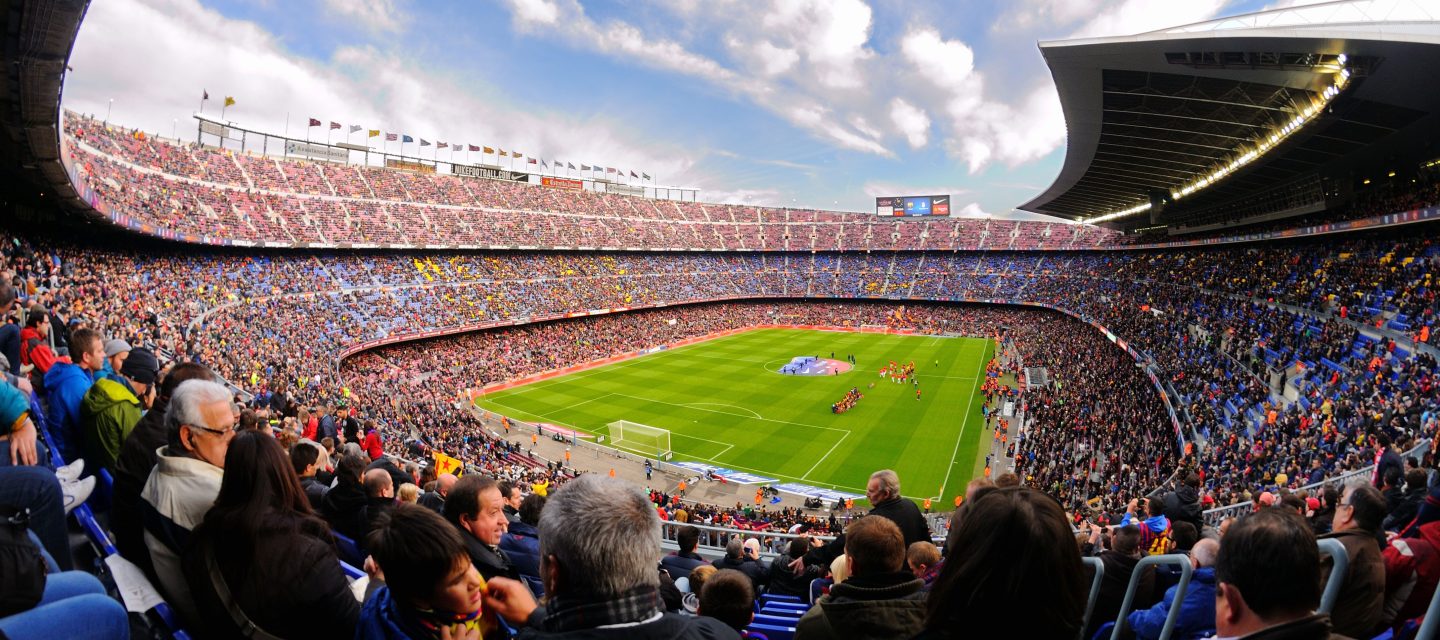Everywhere you go in Europe you are likely to find a football stadium. But some grounds are so large that it is impossible not to spot them. On top of that, visiting a match in these gigantic stadiums is not always that difficult given their capacities. That’s why Kafuraha media has listed the top ten Biggest Football Stadiums in Europe for you.
Top 10 Largest Football Grounds in Europe
| Stadium | Year Built | Current Capacity | Highest Attendance | Event |
|---|---|---|---|---|
Camp Nou Barcelona Barcelona | 1954 – 1957 | 99,354 | 120,000 | Barcelona v Juventus 05/03/1986 |
Wembley London London | 2002 – 2007 | 90,000 | 89,826 | Chelsea v Manchester United 19/05/2007 |
Signal Iduna Park (Westfalenstadion) Dortmund Dortmund | 1971 – 1974 | 81,359 | 83,000 | Dortmund v Schalke 30/01/2004 |
Estadio Santiago Bernabéu Madrid Madrid | 1947 | 81,044 | 128,000 | Real Madrid v Dinamo Zagreb 1974 |
Stade De France Paris Paris | 2004 – 2006 | 80,698 | 80,100 | France v Algeria 20/03/2010 |
San Siro Milan Milan | 1925 – 1926 | 80,018 | 83,381 | Inter Milan v Schalke 21/05/1997 |
Atatürk Olympic Stadium Istanbul Istanbul | 1997 – 2002 | 76,092 | 79,414 | Galatasaray v Olympiacos 31/07/2002 |
Allianz Arena Munich Munich | 2002- 2005 | 75,000 | 75,000 | Numerous |
Old Trafford Manchester Manchester | 1909 – 1910 | 74, 879 | 76,962 | Wolves v Grimsby Town 25/03/1939 |
Olympiastadion Berlin Berlin | 1934-1936 | 74,649 | 88,075 | Hertha BSC v FC Köln 08/03/1969 |
1 – CAMP NOU – SPAIN

Build Cost – 288 million pesetas
If football stadiums are built in the image of the old gladiatorial arenas, then Camp Nou is the most obvious nod back to the time of the Roman Empire. Built in a way that makes it an imposing arena to compete in, it has hosted the home games of FC Barcelona since 1957. Like most of the world’s best stadiums, though, it isn’t reserved solely for the use of one football team. Since 1992 the Catalonian national team have used it as their base and it’s hosted two Champions League finals.
When Spain hosted the 1982 FIFA World Cup Camp Nou was selected as the venue for one of the competition’s semi-finals. Little wonder when you consider that the capacity had increased from 93,000 to about 121,000. The amount of supporters who can enter Camp Nou has been in a state of flux ever since; growing and shrinking depending on safety requirements and the developments of the various stands. In 1982, the same year as it hosted the World Cup, 121,000 people joined the congregation for a mass Mass in the presence of the Pope.
2 – WEMBLEY STADIUM – ENGLAND

By Maciej Kubiak (Wembley StadiumUploaded by BaldBoris) [CC BY 2.0], via Wikimedia Commons
Build Cost – £974 Million
Wembley is one of the most iconic stadiums in the world. Though the Wembley that stands on the site in West London today isn’t the same one that saw England win the World Cup back in 1966, they have both enjoyed some iconic moments and a football supporter from anywhere in the world is just as likely to recognise the current one as the original one from a photograph alone.
Wembley is the home of the England national side, so crowds there are used to enduring disappointment. More importantly, however, the ground is used to host the semi-finals and final of the FA Cup, England’s most prestigious competition. It also hosts the final of the League Cup and has the right to host major European competitions, such as the Champions League final and European Championship matches.
3 – SIGNAL IDUNA PARK (WESTFALENSTADION) – GERMANY

By Dmitrij Rodionov (Own work) [CC BY-SA 3.0], via Wikimedia Commons
Build Cost – €200 Million
Probably best known by the name Westfalenstadion and named after the region in which it was built, the home of Borussia Dortmund is currently called Signal Iduna Park thanks to sponsorship by the Signal Iduna Group. Named as the best football ground anywhere in the world by The Times, the Westfalenstadion is the largest stadium in Germany as far as capacity is concerned. Interestingly, the huge capacity is reduced significantly for international matches as UEFA and FIFA rules declare that stadiums must be all-seater for European games.
That not only reduces the capacity but also the impressiveness of the Westfalenstadion. One of the signature parts of the stadium is what as known as ‘The Yellow Wall’; This is the Südtribüne or South Bank of the ground and it is the largest terrace for spectators who like to stand in all of Europe. The supporters wear the black and yellow of Dortmund and wave flags etc. with the club’s colours on them, hence the name ‘The Yellow Wall’. In 1974 the ground was used to host matched in the FIFA World Cup, with the same thing happening in 2006. It was also the location of the 2001 UEFA Cup Final, the only final of that competition to be decided by a ‘Golden Goal when Liverpool beat Spanish side Alaves.
4 – ESTADIO SANTIAGO BERNABÉU – SPAIN

Build Cost – €1,732,943
Real Madrid are one of the most famous football clubs in the world and Estadio Santiago Bernabéu is therefore one of the best-known football stadiums in the world. Opened in 1947, the home of Real Madrid has undergone numerous renovations over the years in order to keep itself up to date and so that more and more supporters can attend Real’s games. Consequently the capacity of the ground has fluctuated, with around 125,000 able to enter the hallowed stadium in the 1950s.
Much like how Real Madrid and Barcelona compete on the field, the Bernabéu and Camp Nou compete off it. Not literally, obviously – it’s not like Transformers. But there is a sense of ‘anything you can do I can do better’ with the two teams and their home grounds. When Real increase their capacity Barcelona follow suit, always trying to stay ahead of their La Liga competitors. As you’d imagine for a ground of the size and quality of the Bernabéu it hasn’t only hosted Real games over the years. It has hosted the European Cup final five times, most recently under the Champions League branding in 2010. The FIFA World Cup final in 1982 was also played there.
5 – STADE DE FRANCE – FRANCE

By Panorama_stade_de_France.jpg: TaraOderivative work: Inkey [CC BY 2.5, CC-BY-SA-3.0 or GFDL], via Wikimedia Commons
Build Cost – €290 Million
Most national sides in Europe have a dedicated ‘home’ stadium and pretty much always have. Not so the French who have always enjoyed doing things slightly differently. Prior to the 1998 FIFA World Cup, held in stadiums across France, the French side had no specific stadium in which they played their games. Much like with Wembley in England, the Stade de France is nowadays used to host numerous domestic cup finals. Both football and rugby’s Coupe de France finals are held there, along with the Coupe de la Ligue, Challenge de France and Coupe Gambardella matches.
When building work got under way for the stadium it became the first ground in France to be built for a specific reason. The previous one was the Stade Olympique Yves-du-Manoir, which had been erected for the 1924 Summer Olympics – not bad company to keep. When the French football team isn’t playing their games in the stadium it is used to host some rugby games for Stade Francais and Racing Metro 92. It as also hosted musical concerts from artists such as Tina Turner, Beyoncé and Lady Gaga.
6 – SAN SIRO – ITALY

By Nikos Roussos (https://www.flickr.com/photos/comzeradd/4638064233) [CC BY-SA 2.0], via Wikimedia Commons
Build Cost – £5 Million
The official name of the stadium is Stadio Giuseppe Meazza, but to pretty much everyone in the football world it is better known simply as San Siro. There are a number of footballing rival clubs that share a home ground, but none of them are as fierce in their rivalry as the two Milan teams and none of the stadiums are as impressive as the San Siro. AC Milan have called the ground their home since it opened in 1926, with Internazionale joining them there in 1947.
When it opened it went against the grain of other Italian stadiums slightly in that it didn’t have an athletics track around the perimeter. Instead the stadium was designed to be used for nothing but football, something that it hasn’t quite stuck to over the years. It has hosted four different European Cup finals as well as Inter’s leg of the UEFA Cup final when it was played over two matches. Boxing, rugby union matches and musical concerts have also been held at the San Siro.
7 – ATATÜRK OLYMPIC STADIUM – TURKEY

By Bjørn Christian Tørrissen [CC BY-SA 3.0 or GFDL], via Wikimedia Commons
Build Cost – $184 Million
The Ataturk Olympic Stadium, or Atatürk Olimpiyat Stadı to give it its Turkish name, is the largest stadium in Turkey by capacity. It can hold just over 75,000 people and was part of Turkey’s bid to host the 2008 Olympic Games, which were awarded to Beijing in the end. It was awarded 5-stars by UEFA when they categorised it, meaning that it is able to host the finals of UEFA’s biggest events such as the Champions League final. Whilst it is an impressive enough stadium all of its own, it is perhaps best known because of one of those UEFA events it’s allowed to host.
In 2005 Liverpool reached the final of the Champions League and faced Italian giants AC Milan. Milan took a 3-0 advantage into the half-time break, a scoreline that seemed irreversible. The Merseyside club scored three goals in six second-half minutes, however, shocking the Italian club and eventually went on to win the game on penalties. It was known as ‘The Miracle of Istanbul’ and ensured the Ataturk will forever be known for hosting the best comeback ever staged.
8 – ALLIANZ ARENA – GERMANY

Build Cost – €340 Million
Schlauchboot (rubber dinghy), Autoreifen (the car tyre), Luftkissen (the hovercraft) and Weißwurststadion (the white sausage stadium) are just some of the nicknames that the Allianz Arena has been afforded since it opened in 2005. That’s all because of the inflated plastic panels that adorn the side of the stadium and though they make it ripe for mocking they also make it one of the most striking sights in football. The entire exterior of the stadium can change colours, which is pretty ideal when you think that it hosts two different Munich based football teams. It’s most commonly associated with Bayern Munich, but TSV 1860 Munchen also play their home games in the Arena.
When it opened more than a decade ago it had a capacity of just 66,000 but that proved to be far too small for Bayern’s needs. The stadium’s capacity has increased several times since then, taking it to the 75,000 mark that it is currently at. That’s only for league matches, however. On the rare occasion that it hosts a Germany national match it is reduced to 70,000. The stadium’s name comes from it’s sponsor, the financial services provider Allianz. Because that is not an official partner of neither UEFA nor FIFA, the stadium’s name is changed for international and European matches and any Allianz markings are covered up.
9 – OLD TRAFFORD – ENGLAND

Build Cost – £90,000
Old Trafford is the largest club-side stadium in the United Kingdom. It opened its doors for the first time in 1910 and has undergone numerous transformations since then to get it to the state its in now. A large part of Manchester United’s success in the modern era is owed to the club’s forethought to develop the ground during the 1990s. When The Taylor Report into the Hillsborough Disaster declared that all top-flight stadiums in the UK should be all-seater venues, United accepted the temporary reduction of the ground’s capacity in order to allow them to increase the size of the ground in the long-run.
The increased capacity not only allowed more United fans to enter the stadium but it also helped the club to create an increased revenue stream; a revenue stream that sees Manchester United earn millions more pounds than competitors such as Liverpool every time the club plays a home game. A stand was named in honour of the club’s long-serving manager Alex Ferguson in 2001, with the Scot also having a statue modelled after him outside of the ground. There is also a statue in honour of Sir Matt Busby outside the stadium.
10 – OLYMPIASTADION – GERMANY

By Pudelek (Marcin Szala) (Own work) [CC BY-SA 3.0], via Wikimedia Commons
Build Cost – €297 Million
In 1912 the International Olympic Committee declared that Berlin would host the 1916 Summer Olympics. Otto March was hired to design a stadium and came up with an idea for one that would be based near the Grunewald forest. When the First World Way began in 1914 it became clear that an Olympic Games would not be a real possibility for 1916 and so the building was cancelled. Berlin was awarded the 1936 games instead and Otto’s son Werner March was hired to design the new stadium. The Olympiastadion was built between 1934 and 1936 with orders from Hitler, who realised the propaganda potential of the Olympic Games, to make it the most impressive stadium in the world.
After the Second World War the British occupying forces used the Olympiastadion as their headquarters. In 1963 Hertha Berlin started playing their home games in the stadium and in 1974 it was used to host three Group A matches during the FIFA World Cup. It hosted six matches during the 2006 FIFA World Cup including the competition’s final and it also hosted the Champions League final in 2015. It is the ground most commonly used to host the finals of the DFB-Pokal and the Frauen DFB-Pokal. In 2009 the World Championships in Athletics were staged in the Olympiastadion and during the competition Usain Bolt broke both the 100m and 200m world records.






